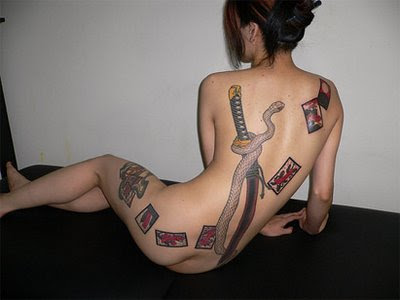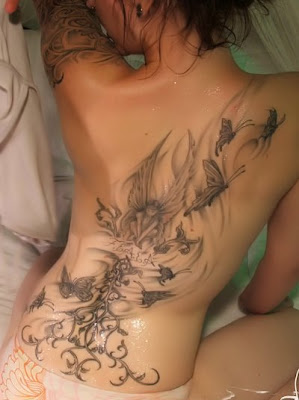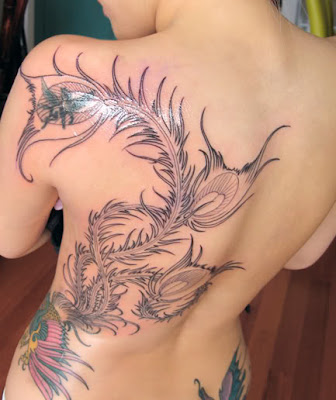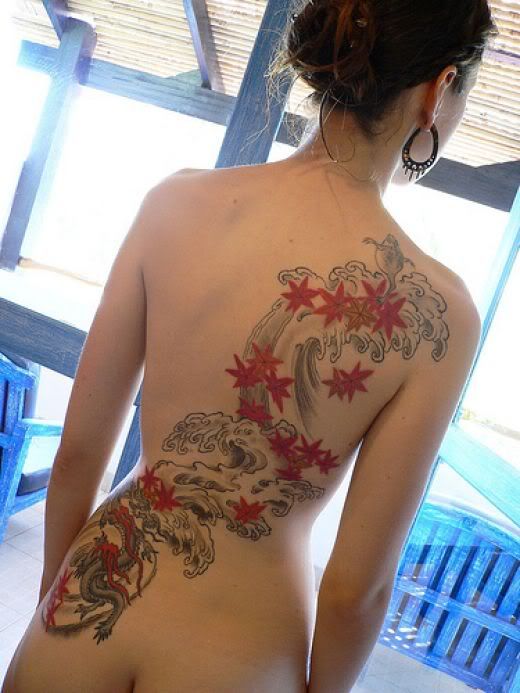From beautiful, exotic flowers to fierce Japanese dragon tattoos, or even large intricately designed samurai warriors, Japanese tattoo symbols and designs work for everyone and anyone. A Japanese koi fish tattoo swimming lazily across a woman's hip, a tiny ring of beautiful cherry blossoms fused together as an armband or at the ankle, a fierce looking emerald serpent slithering up someone's calf, or a samurai warrior and a lady embracing on a back – as wonderful as this art of Horimono seems to be – you might very well find yourself being lured into getting all of these beautiful Japanese symbols and designs made on your body.
Wednesday, June 30, 2010
Beautiful Japanese Tattoos for Girls
From beautiful, exotic flowers to fierce Japanese dragon tattoos, or even large intricately designed samurai warriors, Japanese tattoo symbols and designs work for everyone and anyone. A Japanese koi fish tattoo swimming lazily across a woman's hip, a tiny ring of beautiful cherry blossoms fused together as an armband or at the ankle, a fierce looking emerald serpent slithering up someone's calf, or a samurai warrior and a lady embracing on a back – as wonderful as this art of Horimono seems to be – you might very well find yourself being lured into getting all of these beautiful Japanese symbols and designs made on your body.
CHAPTER TWENTY-ONE -- THE GREEN PROBLEM
Light From Above, 18" x 12"
(With thanks to The Pastel Journal where this was originally published as "It's Not Easy Being Green" )
Red is intense, yellow is cheerful, blue is peaceful, pink is romantic and green is -- a problem. Artists often express consternation over using the color green. It’s as though this one color, so predominant in the landscape, holds some mystery that artists must master. Despite its connotation as a restful, natural color, it can be tricky to use.
Green is found at the very center of the visible spectrum and is the hue to which our eyes are most responsive. We’re able to distinguish more shades of green than any other color, therefore, people have an intuitive, experiential understanding of green, whether consciously or not. This innate awareness can make using accurate and interesting greens a challenge. The most naïve observer can easily spot the wrong green used in a painting. Often the artist knows something is off, but has trouble finding the correction.
Santa Fe, 9" x 18"
WARM OR COOLResiding between the primary colors yellow and blue, directly astride the cusp of warm and cool temperatures on the color wheel, green cannot easily be classified as simply warm or cool. Ask anyone to divide the color wheel in half, with warm on one side and cool on the other, and almost invariably they will draw a line placing yellow on the warm side and yellow-green on the cool. But isolate this same yellow-green and they’ll identify it as a warm color. In the surrounding colors of a painting green may function as either a warm or cool color. This variety of temperature may be part of what makes green challenging to use.
If temperature is the primary issue, why is purple -- made from warm red and cool blue -- not subject to the same complaints among artists? Perhaps part of the reason is that purple resides squarely in the cool half of the color wheel. Add to that the fact that the yellow component of green adds intensity to the mix, while the red factor in purple is related more to temperature. Intensity and temperature are separate issues. The red in purple makes a concentrated color, but not one that’s necessarily intense, while an emphasis on yellow can make green extremely intense. The intensity of yellows used to make green may sometimes make for garish, surrealistic greens. As a result, some artists charge pastel manufacturers with making unnatural or brassy greens.
“So what?” responds Bob Strohsahl, maker of Great American Artworks pastels. “As long as manufacturers are making a full line of reliably standard greens in addition to the ‘garish’ ones, ‘unnatural’ greens might be useful to some artists.” However, he notes that when making pastels, green pigments tend to drift toward blue as they lighten. “The trick is to keep greens green as we make lighter values.” An overabundance of cool, light greens can limit the pastelist’s choices.
Some artists feel overvhelmed at trying to find the correct shade of green. My experience with this problem might be instructive. Years ago I found that I had quite a collection of green pastels, perhaps three times as many sticks as any other color. But when I organized my palette I discovered that instead of having more greens I had multiples of every green made. My dissatisfaction had led me to purchase more and more, trying to find the “right” green.
Wet Sneaker Morning, 12" x 18"
The cure came when master pastelist Albert Handell, who has been so instructive to so many emerging pastelists, urged me to paint only green subject matter. He suggested I paint trees, bushes, grasses or any other subject that was solely or predominantly green. As I progressed in this experiment, bored with the same old greens, I quickly reached into the rest of my palette to add interest to the work. I soon discovered that I could use red, lavender, gold, orange, purple, magenta, blue, yellow and any other color I had on hand to enhance my greens. Using green became an adventure as I explored these many variations.LOCAL COLOR
Like so many, I was convinced that because the local color was green I had to begin with and continue using green there. Instead, a great variety of colors under, over and next to green make it far more interesting and believable. Think, “warm in the sunlight, cool in the shade.” Sunlit greens contain somewhat more warmth, hence yellow, so begin the warm areas of green using yellow, orange, red or pink. Greens in shade are cooler, so use blue, purple or magenta.
Evening Complements (detail)
Be careful not to over-green areas. If you need to strengthen the colors in and around green, you might begin with a grisaille underpainting or an underdrawing done in charcoal and choose colors based on the light to dark values needed. Based on value alone you can use a great number of different colors together. Color is then predicated on the tone first, which can make for exciting color choices. This can strengthen green by adding a host of colors of the same or similar value alongside or mixed into the green.
Instead of trying to find the green that most accurately matches what you see, use another color to mimic, replace or strengthen it. In an area of shadow use the darkest blue or a very dark burgundy or purple -- and no green. In the sunlight, choose bright orange or magenta, rather than green. Force yourself to think about value before color, as well as the temperature of the color.
MAKING MUD
Won’t all those different colors make mud? Many artists theorize that the recipe for a muddy, grimy color is one part warm mixed with one part cool. However, mud is a function of temperature and value. If you mix warms and cools the result will often look muddy, but mud is most affected by the use of differing values. When you’re careful to retain analogous values in an area you can avoid dirty color. For example, look at the greens in Evening Complements. The lighter areas of foliage are made using orange, copper, gold, lavender, yellow-green and green. These warm and cool colors are of the same value, resulting in an exciting, clear warm green that isn’t muddy or gloomy. Likewise, the shadowed side of the foliage is made up of red-violet, cool purple, blue, turquoise and green. Again, the similarity of values allows clear color even though the temperatures are both warm and cool.
Lavender Sky (detail)
According to artist and pastel manufacturer Terry Ludwig, over-blending colors is the main culprit in making mud. “Some blending can be useful, but if you don’t keep the colors somewhat separate they become mud, and if they contain too much white it gets pasty looking too.” Using light layers or broken color can create optical blending that’s far more interesting than the single-note, ordinary colors that result from too much blending.MAKING SPACE
In a landscape the goal is to create an impression of space and distance. As green fades into the distance the yellow component is filtered out by the atmosphere. To give your painting a sense of air, remember that the farther away they are, the cooler, bluer and paler the greens. This is true of all colors, of course, but this makes green particularly challenging because it’s made primarily of warm yellow, which appears close, and cool blue, which creates distance. Use warm yellow-greens in the foreground, and cool, blued greens for the background. Don’t allow olive green to become too blue in the distance, or blue-green to become too yellow in the foreground.
Significant humidity can increase the number of values perceived and necessitate a greater palette of greens since a wet climate is usually a green place. Sometimes this can baffle even a green connoisseur.
Ludwig, whose set of 85 greens have become foundational for many pastelists, was heard to remark while painting on location in sultry Atlanta, Ga., that he didn’t have the right green. His greens, which run the gamut from intense warm yellow-greens to the darkest cool blue-greens, enhanced with additions of cool reds, pale blues and warm yellows, were made to fill colors he felt were missing from his palette. “But there are a lot of nuances in Georgia in August,” he chuckles, noting he’s from Colorado, “and I still didn’t have enough with me.”
Certain greens characterize different areas of the country, but does that mean more artists in Vermont use Vermont Green, one of the Great American colors? “There’s some regional preference,” Strohsahl says. “Blue-greens for the northeast, yellow-greens in the southwest, although this is a generalization. There are lots of exceptions.” Vermont green is called that simply because, “I like Vermont,” explains Strohsahl. “Green sales are fairly consistent across the board. I think this is so because green occurs everywhere and not just in vegetation.”
COLOR WHEEL
No photograph can possibly represent the variety of greens you see in the world with your eye. The experience of painting on location will teach you more about green than any photograph. The human eye can see some 7,000,000 colors, a variety no film can begin to approach, so to appreciate the diversity of color it’s best to spend time observing and recording what you see in nature.
Final Touches, 12" x 9"
Our eyes have millions of light-sensitive photoreceptor cells called cones. When saturated with one color, the eye automatically supplies the complementary color as an after-image. You may have experienced the effect of staring at a green square and, upon looking away, seeing a mysterious red square floating in its place. The after-image provides the complement of the color. While you’re on location, search out the red after-image of green and record it in your painting. This is guaranteed to enliven your colors, since complements invariably heighten visual contrasts.
As you practice seeing in a very green environment you will begin to perceive all the colors of the color wheel. Look for the yellows and oranges of green in sunlight, the blues and purples of the shadowed greens, and the afterimage of red amid all of the numerous greens there.
Use warm and cool greens to add depth. Enhance green with all the colors in your palette, paying attention to how much you blend or leave the strokes visible. Layer colors together to boost the power of the greens you have on hand. Seek the ways that you can record all the beauty of green, the restful and useful color of nature.
Sunday, June 27, 2010
Friday, June 25, 2010
Celebrating Summer
I'm having a hard time believing we've already reached the last weekend in June. Every year, I make a mental note to take time to fully enjoy summer and all the things I love about it. To savor the season the way I did when I was little.
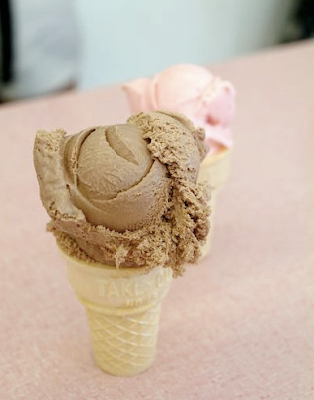 Evan Sklar
Evan Sklar
 Randy Harris Photography
Randy Harris Photography

Union Photography

Katie Baum via 20x200
 Evan Sklar
Evan SklarBut, for some reason, time refuses to move as slowly as it did then. As much as I adore Fall and the sweaters, boots, and tights that come with it, I always find myself surprised by its arrival and slightly disappointed another summer has come and gone without feeling I've celebrated it to its fullest.
 Randy Harris Photography
Randy Harris Photography While my days don't promise to be leisurely this summer, I am trying to make sure I embrace as many of my favorite things about this time of year as I can; I am hoping this will help me feel I enjoyed the season as much as possible by the time cool air start to blow again.

Union Photography

Katie Baum via 20x200
I intend to keep adding to my list over the coming months, and I am going to do some work towards reaching my goal right now as E and I head out to grab some of our favorite gelato! I hope whatever your plans, your weekend is full of simple delights of the season too. Have a great one!
Thursday, June 24, 2010
CHAPTER TWENTY -- TEMPERATURE
Hot Afternoon, 9" x 12"
What does the temperature of a color do in your painting? It may be as simple as warm colors advance and cool colors recede, but perhaps there is more. What happens when you place a warm color over a cool one -- or vice versa? Does anything different happen if you place a hot color beneath or on top of a cool one?
Let’s begin with a definition of warm, cool and hot. There are three primary colors: red, yellow and blue. Two of those colors – red and yellow – are warm, and only one – blue – is cool. Where you divide the color wheel into warm or cool is usually a personal decision, yet what artist has not used warm purple or cool orange? Nonetheless, basically two-thirds of the colors on the wheel are warm.
When we describe a hot color we usually refer to temperature only to a degree. More often the word “hot” means intense, and applies to more colors than just those in the red and yellow range. Usually, however, these intense colors are warm in nature. For instance, you might have a hot orange or red, but what do you picture when I say hot green or hot blue?

 If you pictured a green with dashes of red beneath it or a blue with orange peeking through, you are thinking like an artist. When we put complements together, whether on top of one another or side by side, we are using temperature to affect color.
If you pictured a green with dashes of red beneath it or a blue with orange peeking through, you are thinking like an artist. When we put complements together, whether on top of one another or side by side, we are using temperature to affect color.If you place a hot color beneath one of lesser intensity, say layering a bright yellow under a pale blue, you often achieve an optical mix that results in green. Doesn’t the same thing happen if you place a pale yellow beneath a pale blue? Yes, but to a much lesser degree. The result of that combination is usually described more as a slightly bluish green.

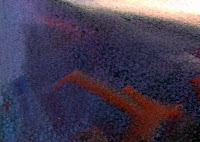 Much of the effect is dependent on how you choose to lay down your strokes. For instance, you might decide to put down a soft layer of yellow and then cover that with another soft layer of blue. The result blends on the paper into bluish green. If you put down a thick impasto stroke of yellow and cover it with choppy strokes of blue it results in broken color that suggests green. Think of the difference in layering the sky or the grasses -- soft, smooth layers of sky versus broken strokes of grass. If you use the side of your pastel to slightly blend layers you achieve a very different look using temperature than you do if you use the end of the pastel to put in lines. Both become green but to varying degrees.
Much of the effect is dependent on how you choose to lay down your strokes. For instance, you might decide to put down a soft layer of yellow and then cover that with another soft layer of blue. The result blends on the paper into bluish green. If you put down a thick impasto stroke of yellow and cover it with choppy strokes of blue it results in broken color that suggests green. Think of the difference in layering the sky or the grasses -- soft, smooth layers of sky versus broken strokes of grass. If you use the side of your pastel to slightly blend layers you achieve a very different look using temperature than you do if you use the end of the pastel to put in lines. Both become green but to varying degrees.Experiment with putting down different colors. What happens?
Try hot over cool.
Cool over hot.
Warm over hot.
Hot over warm.
Warm over cool.
Cool over warm.
Cool over cool.
Warm over warm.
Hot over hot.
Next, how about using a split-complement, the color to each side of the complement, beneath or on top? How does that affect things? That’s too many color experiments to count – I'll let you make that chart.
I challenge you to simply experiment with colors and see what happens when you try different combinations. The charts you make will help you remember what you discovered. Then apply what you learn to layering colors in your paintings.
Almost Spring, 12" x 18"
Wednesday, June 23, 2010
Amazing Art of Japanese Tattoo Designs Especiahttp://www.blogger.com/imlly Japanese Geisha Tattoo Ideas With Image Japanese Geisha Calf Tattoo Gallery
 Amazing Art of Japanese Tattoo Designs Especially Japanese Geisha Tattoo Ideas With Image Japanese Geisha Calf Tattoo Gallery 1
Amazing Art of Japanese Tattoo Designs Especially Japanese Geisha Tattoo Ideas With Image Japanese Geisha Calf Tattoo Gallery 1 Amazing Art of Japanese Tattoo Designs Especially Japanese Geisha Tattoo Ideas With Image Japanese Geisha Calf Tattoo Gallery 2
Amazing Art of Japanese Tattoo Designs Especially Japanese Geisha Tattoo Ideas With Image Japanese Geisha Calf Tattoo Gallery 2 Amazing Art of Japanese Tattoo Designs Especially Japanese Geisha Tattoo Ideas With Image Japanese Geisha Calf Tattoo Gallery 3
Amazing Art of Japanese Tattoo Designs Especially Japanese Geisha Tattoo Ideas With Image Japanese Geisha Calf Tattoo Gallery 3 Amazing Art of Japanese Tattoo Designs Especially Japanese Geisha Tattoo Ideas With Image Japanese Geisha Calf Tattoo Gallery 4
Amazing Art of Japanese Tattoo Designs Especially Japanese Geisha Tattoo Ideas With Image Japanese Geisha Calf Tattoo Gallery 4 Amazing Art of Japanese Tattoo Designs Especially Japanese Geisha Tattoo Ideas With Image Japanese Geisha Calf Tattoo Gallery 5
Amazing Art of Japanese Tattoo Designs Especially Japanese Geisha Tattoo Ideas With Image Japanese Geisha Calf Tattoo Gallery 5 Amazing Art of Japanese Tattoo Designs Especially Japanese Geisha Tattoo Ideas With Image Japanese Geisha Calf Tattoo Gallery 6
Amazing Art of Japanese Tattoo Designs Especially Japanese Geisha Tattoo Ideas With Image Japanese Geisha Calf Tattoo Gallery 6Amazing Art of Japanese Tattoo Designs Especiahttp://www.blogger.com/imlly Japanese Geisha Tattoo Ideas With Image Japanese Geisha Calf Tattoo Gallery
 Amazing Art of Japanese Tattoo Designs Especially Japanese Geisha Tattoo Ideas With Image Japanese Geisha Calf Tattoo Gallery 1
Amazing Art of Japanese Tattoo Designs Especially Japanese Geisha Tattoo Ideas With Image Japanese Geisha Calf Tattoo Gallery 1 Amazing Art of Japanese Tattoo Designs Especially Japanese Geisha Tattoo Ideas With Image Japanese Geisha Calf Tattoo Gallery 2
Amazing Art of Japanese Tattoo Designs Especially Japanese Geisha Tattoo Ideas With Image Japanese Geisha Calf Tattoo Gallery 2 Amazing Art of Japanese Tattoo Designs Especially Japanese Geisha Tattoo Ideas With Image Japanese Geisha Calf Tattoo Gallery 3
Amazing Art of Japanese Tattoo Designs Especially Japanese Geisha Tattoo Ideas With Image Japanese Geisha Calf Tattoo Gallery 3 Amazing Art of Japanese Tattoo Designs Especially Japanese Geisha Tattoo Ideas With Image Japanese Geisha Calf Tattoo Gallery 4
Amazing Art of Japanese Tattoo Designs Especially Japanese Geisha Tattoo Ideas With Image Japanese Geisha Calf Tattoo Gallery 4 Amazing Art of Japanese Tattoo Designs Especially Japanese Geisha Tattoo Ideas With Image Japanese Geisha Calf Tattoo Gallery 5
Amazing Art of Japanese Tattoo Designs Especially Japanese Geisha Tattoo Ideas With Image Japanese Geisha Calf Tattoo Gallery 5 Amazing Art of Japanese Tattoo Designs Especially Japanese Geisha Tattoo Ideas With Image Japanese Geisha Calf Tattoo Gallery 6
Amazing Art of Japanese Tattoo Designs Especially Japanese Geisha Tattoo Ideas With Image Japanese Geisha Calf Tattoo Gallery 6
Subscribe to:
Posts (Atom)










